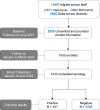SARS-CoV-2 cross-sectional seroprevalence study among public school staff in Metro Vancouver after the first Omicron wave in British Columbia, Canada
- PMID: 37308276
- PMCID: PMC10276956
- DOI: 10.1136/bmjopen-2022-071228
SARS-CoV-2 cross-sectional seroprevalence study among public school staff in Metro Vancouver after the first Omicron wave in British Columbia, Canada
Abstract
Objective: To determine the SARS-CoV-2 seroprevalence among school workers within the Greater Vancouver area, British Columbia, Canada, after the first Omicron wave.
Design: Cross-sectional study by online questionnaire, with blood serology testing.
Setting: Three main school districts (Vancouver, Richmond and Delta) in the Vancouver metropolitan area.
Participants: Active school staff enrolled from January to April 2022, with serology testing between 27 January and 8 April 2022. Seroprevalence estimates were compared with data obtained from Canadian blood donors weighted over the same sampling period, age, sex and postal code distribution.
Primary and secondary outcomes: SARS-CoV-2 nucleocapsid antibody testing results adjusted for test sensitivity and specificity, and regional variation across school districts using Bayesian models.
Results: Of 1850 school staff enrolled, 65.8% (1214/1845) reported close contact with a COVID-19 case outside the household. Of those close contacts, 51.5% (625/1214) were a student and 54.9% (666/1214) were a coworker. Cumulative incidence of COVID-19 positive testing by self-reported nucleic acid or rapid antigen testing since the beginning of the pandemic was 15.8% (291/1845). In a representative sample of 1620 school staff who completed serology testing (87.6%), the adjusted seroprevalence was 26.5% (95% CrI 23.9% to 29.3%), compared with 32.4% (95% CrI 30.6% to 34.5%) among 7164 blood donors.
Conclusion: Despite frequent COVID-19 exposures reported, SARS-CoV-2 seroprevalence among school staff in this setting remained no greater than the community reference group. Results are consistent with the premise that many infections were acquired outside the school setting, even with Omicron.
Keywords: COVID-19; EPIDEMIOLOGY; Epidemiology; Public health; Schools.
© Author(s) (or their employer(s)) 2023. Re-use permitted under CC BY-NC. No commercial re-use. See rights and permissions. Published by BMJ.
Conflict of interest statement
Competing interests: CO'R is an employee of the Vancouver School District, but the latter was not involved in the design, analysis, interpretation of data or the drafting of this manuscript. LifeLabs played no role in the study other than providing a service for the collection of blood samples.
Figures
Similar articles
-
SARS-CoV-2 seroprevalence among Vancouver public school staff in British Columbia, Canada: a cross-sectional study.BMJ Open. 2022 Apr 5;12(4):e057846. doi: 10.1136/bmjopen-2021-057846. BMJ Open. 2022. PMID: 35383082 Free PMC article.
-
Seroprevalence of SARS-CoV-2 Antibodies Among Children in School and Day Care in Montreal, Canada.JAMA Netw Open. 2021 Nov 1;4(11):e2135975. doi: 10.1001/jamanetworkopen.2021.35975. JAMA Netw Open. 2021. PMID: 34812845 Free PMC article.
-
Serial cross-sectional estimation of vaccine-and infection-induced SARS-CoV-2 seroprevalence in British Columbia, Canada.CMAJ. 2022 Dec 5;194(47):E1599-E1609. doi: 10.1503/cmaj.221335. CMAJ. 2022. PMID: 36507788 Free PMC article.
-
Seropositivity of SARS-CoV-2 in an unvaccinated cohort in British Columbia, Canada: a cross-sectional survey with dried blood spot samples.BMJ Open. 2022 Aug 29;12(8):e062567. doi: 10.1136/bmjopen-2022-062567. BMJ Open. 2022. PMID: 36038173 Free PMC article.
-
Risk of infection and contribution to transmission of SARS-CoV-2 in school staff: a systematic review.BMJ Open. 2021 Nov 3;11(11):e052690. doi: 10.1136/bmjopen-2021-052690. BMJ Open. 2021. PMID: 34732489 Free PMC article.
Cited by
-
Risk of Reinfection and Incidence of Chronic Symptoms After SARS-CoV-2 Infections.Open Forum Infect Dis. 2024 Oct 15;11(10):ofae608. doi: 10.1093/ofid/ofae608. eCollection 2024 Oct. Open Forum Infect Dis. 2024. PMID: 39474442 Free PMC article.
-
Factors associated with SARS-CoV-2 infection in unvaccinated children and young adults.BMC Infect Dis. 2024 Jan 15;24(1):91. doi: 10.1186/s12879-023-08950-1. BMC Infect Dis. 2024. PMID: 38225625 Free PMC article.
-
Chronic health consequences of the COVID-19 pandemic on school workers: a cross-sectional post-pandemic analysis.BMJ Open. 2025 Jul 28;15(7):e095685. doi: 10.1136/bmjopen-2024-095685. BMJ Open. 2025. PMID: 40730406 Free PMC article.
-
A Novel Anti-nucleocapsid Antibody Avidity Method for Identifying SARS-CoV-2 Reinfections.J Infect Dis. 2024 Sep 23;230(3):e579-e583. doi: 10.1093/infdis/jiae072. J Infect Dis. 2024. PMID: 38442331 Free PMC article.
-
COVID-19 endgame: From pandemic to endemic? Vaccination, reopening and evolution in low- and high-vaccinated populations.J Theor Biol. 2023 Feb 21;559:111368. doi: 10.1016/j.jtbi.2022.111368. Epub 2022 Nov 24. J Theor Biol. 2023. PMID: 36436733 Free PMC article.
References
-
- Hutchison SM, Watts A, Gadermann A, et al. . School staff and teachers during the second year of COVID-19: higher anxiety symptoms, higher psychological distress, and poorer mental health compared to the general population. J Affect Disord Rep 2022;8:100335. 10.1016/j.jadr.2022.100335 - DOI - PMC - PubMed
Publication types
MeSH terms
Substances
LinkOut - more resources
Full Text Sources
Medical
Miscellaneous

